Butterflies often seen on the horse
trails
These are some of the more common
butterflies seen while horseback riding around Cocoa
As you
explore the impressive forests, scrub and swamps you will see many
of the butterflies detailed below. Sadly, the life of a butterfly is
very short - from 3 to 10 days. Most adult butterflies found in
Florida feed on flower nectar. Some visit a variety of flowers and
others seem to prefer a more specialized menu.
Butterflies generally are attracted to brightly colored simple
flowers that are not too deep and that are wide enough for good
perching platforms.
Most of the butterflies breed all year round so you are guaranteed
to see some of them on your trail ride.
Zebra
Longwing (Heliconius charitonius)
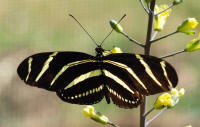 In 1996, Governor Chiles designated the Zebra Longwing as Florida's
official state butterfly. The zebra, easily identified by its long
black wings striped with yellow, is found in all parts Florida year round. In 1996, Governor Chiles designated the Zebra Longwing as Florida's
official state butterfly. The zebra, easily identified by its long
black wings striped with yellow, is found in all parts Florida year round.
Zebras fly slowly and don't startle easily, making them easy to
follow and observe. A zebra resting at dusk can be gently coaxed to
climb on your finger and to return, unflustered, to its perch.
Zebras roost in groups, returning to the same location each night.
Zebra longwings feed on nectar and pollen and they are the only
butterflies known to eat pollen which is probably why they have a
long lifespan of about six months. If denied pollen, they live a
more typical lifespan of about one month.
Zebras are especially fond of the nectar of plants of the
Verbena
family. Passion vines (Passiflora) host zebra eggs and
larvae. Passion vines contain toxins that are consumed by the larvae
and make the adult butterflies poisonous to predators. The tiny
(1.2mm x 0.7mm) yellow egg is usually laid on new foliage, sometimes
in a group. The newly emerging caterpillar is yellow. It will go
through four or five instars (moltings), becoming white with six bands of
black spots and black branched spines and a greenish-white head that
is also spotted and has two spines. When it pupates it forms a
chrysalis that looks like a spiny curled, dried leaf. If disturbed,
the chrysalis makes a rasping sound.
The entire process, from the time the egg is laid until the
butterfly emerges, is dependent on temperature, taking longer during
cool weather. Under optimum conditions, it make take as little as
three weeks.
Gulf Fritillary
(Agraulis vanillae)
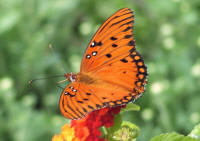 The
Gulf fritillary is a medium-sized, orange butterfly with black
markings and somewhat elongated wings. Its hind wings below are
covered with numerous silvery, mercury-like patches that distinguish
this butterfly from the similar and equally common monarch. Fond of
open, disturbed sites, the Gulf fritillary frequently stops to
nectar at colorful flowers, especially Passion Vine. The Gulf
fritillary is one of several migratory species in the Southeast. As
fall approaches, adults begin a mass southward migration eventually
arriving in the warm confines of South Florida to overwinter. The
Gulf fritillary is a medium-sized, orange butterfly with black
markings and somewhat elongated wings. Its hind wings below are
covered with numerous silvery, mercury-like patches that distinguish
this butterfly from the similar and equally common monarch. Fond of
open, disturbed sites, the Gulf fritillary frequently stops to
nectar at colorful flowers, especially Passion Vine. The Gulf
fritillary is one of several migratory species in the Southeast. As
fall approaches, adults begin a mass southward migration eventually
arriving in the warm confines of South Florida to overwinter.
White Peacock (Agraulis vanillae)
 As its name implies,
the white peacock is a whitish butterfly, but it has light
orange wing borders and a lot of gray brown markings. Each
forewing bears a single solid black spot and the hind wings
have two smaller black dots. The white peacock is a common
butterfly of open, weedy sites along waterways or ditches,
where its larval host plants typically grow. It has a fast,
low, erratic flight and is often difficult to approach.
Females are significantly larger than males. Although common
throughout southern Texas and Florida, the species regularly
moves northward each year to establish temporary breeding
colonies. As its name implies,
the white peacock is a whitish butterfly, but it has light
orange wing borders and a lot of gray brown markings. Each
forewing bears a single solid black spot and the hind wings
have two smaller black dots. The white peacock is a common
butterfly of open, weedy sites along waterways or ditches,
where its larval host plants typically grow. It has a fast,
low, erratic flight and is often difficult to approach.
Females are significantly larger than males. Although common
throughout southern Texas and Florida, the species regularly
moves northward each year to establish temporary breeding
colonies.
Giant Swallowtail (Papilio cresphontes)
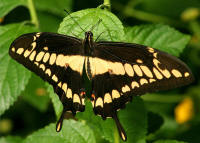 With
a wing span often exceeding five inches, the giant swallowtail is
one of the largest North American butterflies. Ranging throughout
most of the U.S., the giant swallowtail is particularly abundant in
the southern states. The giant swallowtail is at home in a wide
variety of habitats including forest edges, agricultural farmland,
dry pinelands, citrus groves and suburban gardens. The larvae feed
on citrus-family plants such as prickly ash, hercules club, wild
lime, hoptree, all kinds of citrus trees and rue (Ruta graveolens).
The larvae occasionally become minor pests on commercial citrus
crops. With
a wing span often exceeding five inches, the giant swallowtail is
one of the largest North American butterflies. Ranging throughout
most of the U.S., the giant swallowtail is particularly abundant in
the southern states. The giant swallowtail is at home in a wide
variety of habitats including forest edges, agricultural farmland,
dry pinelands, citrus groves and suburban gardens. The larvae feed
on citrus-family plants such as prickly ash, hercules club, wild
lime, hoptree, all kinds of citrus trees and rue (Ruta graveolens).
The larvae occasionally become minor pests on commercial citrus
crops.
Red Admiral (Vanessa atalanta)
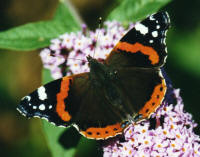 One
of the most common, widespread and recognizable butterflies in the
world, the red admiral occurs throughout much of Europe, Asia and
North America. The bright red stripes of the wings above are in
stark contrast to the mottled blue, cream and brown undersides. The
red admiral has a strong affinity for flowers and is a familiar
sight in most gardens, backyards, roadsides, city parks, forest
edges and open areas. Strong and agile on the wing, the red admiral
is best observed and most easily approached while nectaring. Adults
can also be found at rotting fruit, tree sap and animal dung. Males
readily establish territories and often return to the same perch day
after day. One
of the most common, widespread and recognizable butterflies in the
world, the red admiral occurs throughout much of Europe, Asia and
North America. The bright red stripes of the wings above are in
stark contrast to the mottled blue, cream and brown undersides. The
red admiral has a strong affinity for flowers and is a familiar
sight in most gardens, backyards, roadsides, city parks, forest
edges and open areas. Strong and agile on the wing, the red admiral
is best observed and most easily approached while nectaring. Adults
can also be found at rotting fruit, tree sap and animal dung. Males
readily establish territories and often return to the same perch day
after day.
Viceroy (Basilarchia
archippus) April - Sept
 Closely
resembling the toxic monarch and queen butterflies, the viceroy was
once thought to be nothing more than a clever palatable mimic.
Recent scientific research, however, has shown that the viceroy does
in fact sequester toxic chemicals from its larval host plants that
make it very bad-tasting to a variety of predators. A classic
example of "Mullerian mimicry", all three noxious species (the
viceroy, monarch and queen) gain protection by displaying a similar
overall color pattern. Any predator attempting to eat any one member
of the species trio is likely to get a bad stomach ache or at least
a bad taste in its mouth. When a similar looking butterfly is
subsequently encountered, the predator will probably avoid the meal,
not wanting to make the same unpleasant culinary mistake again. Closely
resembling the toxic monarch and queen butterflies, the viceroy was
once thought to be nothing more than a clever palatable mimic.
Recent scientific research, however, has shown that the viceroy does
in fact sequester toxic chemicals from its larval host plants that
make it very bad-tasting to a variety of predators. A classic
example of "Mullerian mimicry", all three noxious species (the
viceroy, monarch and queen) gain protection by displaying a similar
overall color pattern. Any predator attempting to eat any one member
of the species trio is likely to get a bad stomach ache or at least
a bad taste in its mouth. When a similar looking butterfly is
subsequently encountered, the predator will probably avoid the meal,
not wanting to make the same unpleasant culinary mistake again.
Cloudless Sulphur (Phoebis sennae)
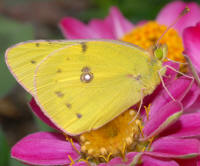 The cloudless sulphur is a large
yellow butterfly with a fast, powerful fight. Males are virtually
solid yellow above and below and have few visible markings. Females
may be yellow, orange-yellow or white, and they have a faint dark
border on the upper surface of their wings. Although a common
year-round resident in much of peninsular Florida, the cloudless
sulphur rapidly extends its range northward each spring and
eventually establishes breeding colonies as far north as Canada and
the Midwest by the end of summer. As cool autumn weather approaches,
adults from the final generation begin a return migration, coming
back to the Deep South to overwinter.

|